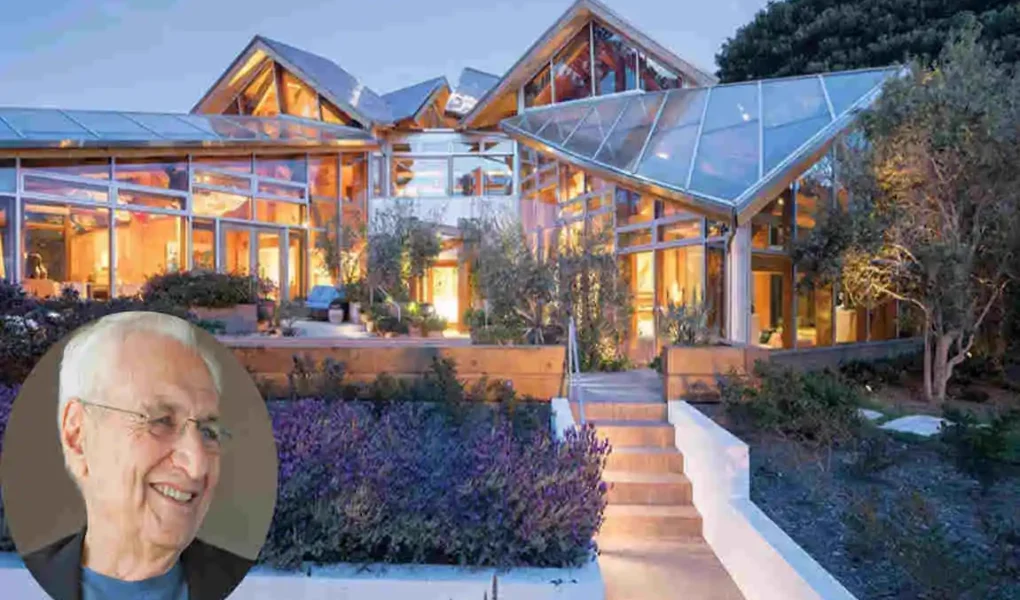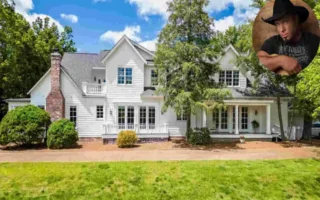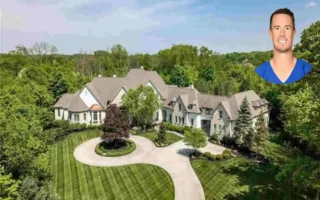Frank Gehry is an iconic architect renowned for his innovative and unconventional designs that have left an indelible mark on the world of architecture. His unique style, characterized by deconstructivism, the use of unusual materials, and bold, sculptural forms, has given rise to some of the most striking and recognizable buildings in the world. Among his many celebrated works, Frank Gehry’s houses hold a special place, showcasing his signature style in a more intimate, residential setting.
| Attribute | Details |
|---|---|
| Full Name | Frank Owen Gehry (born Frank Owen Goldberg) |
| Date of Birth | February 28, 1929 |
| Nationality | Canadian-American |
| Occupation | Architect |
| Education | USC School of Architecture (Graduated 1954) |
| Notable Works | Guggenheim Museum Bilbao, Walt Disney Concert Hall, Louis Vuitton Foundation |
| Net Worth | Approximately $100 million (2025 estimate) |
| Current Residence | Santa Monica, California, USA |
Who is Frank Gehry?

Frank Gehry is a Canadian-American architect and designer, born Frank Owen Goldberg on 28 February 1929, in Toronto, Canada. He is renowned for his distinctive and innovative architectural style that blends everyday materials with dynamic, sculptural forms often categorized as deconstructivist. Gehry’s most famous works include the Guggenheim Museum Bilbao in Spain, the Walt Disney Concert Hall in Los Angeles, and the Louis Vuitton Foundation in Paris. His architecture is renowned for its bold, unconventional shapes and innovative use of materials, including titanium and stainless steel.
Gehry began his career in the 1960s and rose to prominence in the 1970s with experimental designs. He has received many prestigious awards, including the Pritzker Architecture Prize, the National Medal of Arts, and the Presidential Medal of Freedom. Gehry’s influence has significantly shaped contemporary architecture, with many of his buildings becoming iconic cultural landmarks and tourist attractions. Beyond architecture, he has also designed furniture and jewelry.
Understanding Frank Gehry Houses
Definition and Characteristics
Frank Gehry’s houses are residential structures designed by the legendary architect, embodying his distinctive approach to design. These homes are characterized by their:
- Deconstructivist style, which breaks away from traditional design principles
- Use of unconventional materials, such as corrugated metal, plywood, and chain-link fencing
- Unique, sculptural shapes that challenge the norms of residential architecture
Gehry’s Influence on Modern Architecture
Gehry’s work has had a profound impact on modern architecture, inspiring countless designers to push the boundaries of what is possible in the built environment. His houses, in particular, have demonstrated that residential architecture can be just as innovative and expressive as large-scale public buildings.
Some renowned Frank Gehry houses include:
- Gehry Residence in Santa Monica, California
- Schnabel House in Brentwood, California
- Winton Guest House in Wayzata, Minnesota
History and Background of the Santa Monica Frank Gehry House
Original Design and Construction
| Attribute | Details |
|---|---|
| Address | 1002 22nd Street, Santa Monica, California, USA |
| Type | Single Family House (originally a 1920s Dutch colonial-style bungalow) |
| Site Area | Approximately 6,321 square feet |
| Building Area | Approximately 2,265 square feet |
| Architectural Design | Renovation and extension of an existing house wrapped with metal slipcover; use of unconventional materials like corrugated steel, chain-link fencing, plywood, aluminum glass; tilted glass cubes, exposed structural elements; considered an early example of deconstructivism but denied by Gehry; intentionally cluttered, expressionistic, and artistically intuitive design with off-the-shelf, ordinary cheap tech materials. The house exhibits a contrast between the old and new, blending traditional and modern avant-garde styles. |
| Notable Features | Old Dutch colonial house kept intact underneath modern additions; walls stripped to original frame; random slanted lines and angled protrusions; large glass surfaces; visible brick chimney; behind trees for privacy. |
| History | Purchased in 1977 by Frank and Berta Gehry; major renovation and extension completed in 1978; sparked controversy among neighbors for unconventional aesthetics; considered a landmark in architectural experimentation and iconic work in Gehry’s career. Gehry still owned the house as of recent years and has another residence in Rustic Canyon but plans to keep this house in the family. |
| Estimated Worth | Valued in the multi-million dollar range (exact value varies based on location and market, typically tens of millions given iconic status and location in Santa Monica) |
The Frank Gehry House in Santa Monica was initially designed and built in the late 1970s. The project began when Gehry was commissioned by a client seeking a unique, unconventional home that would stand out from its surrounding neighborhood.
Unique Challenges and Innovations
During the design and construction process, Gehry faced several challenges, including working within the constraints of a relatively small lot and navigating local building codes. However, these limitations ultimately led to some of the house’s most innovative features, such as its distinctive angular forms and the use of unexpected materials like corrugated metal and plywood.
Timeline and Milestones
The construction of the Santa Monica Frank Gehry House was completed in 1978, marking a significant milestone in the architect’s career. The house quickly gained attention from both the architectural community and the general public, cementing Gehry’s reputation as a visionary designer.
Architectural Features of the Santa Monica Gehry House

Structural Design
The Santa Monica Frank Gehry House is characterized by its bold, angular forms and unconventional use of materials. The structure comprises a series of interlocking volumes, each clad in a distinct material, resulting in a visually striking and dynamic composition.
Materials Used
Gehry chose to use a variety of materials in the house, including:
- Corrugated metal
- Plywood
- Glass
- Chain-link fencing
These materials were selected for their affordability, durability, and ability to create unique textures and visual effects.
Interior Design Highlights
The interior of the house is equally impressive, featuring an open, fluid layout that allows for ample natural light and a seamless connection between indoor and outdoor spaces. The use of exposed structural elements and raw materials creates a sense of honesty and authenticity throughout the home.
Sustainable and Innovative Elements
Although sustainability was not a primary focus in the 1970s, the Santa Monica Frank Gehry House incorporates several innovative elements that contribute to its overall efficiency and performance. For example, the use of natural ventilation and the strategic placement of windows help reduce the need for artificial cooling.
The Cultural and Artistic Significance of Gehry’s Santa Monica House
Gehry’s Signature Style
The Santa Monica house is a prime example of Gehry’s signature style, showcasing his ability to create avant-garde, sculptural forms that challenge traditional notions of what a house should look like. The home’s distinctive appearance has made it a local landmark and a source of inspiration for architects and designers worldwide.
Impact on Local Architecture and Artistic Communities
The presence of the Frank Gehry House in Santa Monica has had a significant impact on the local architectural and artistic communities. The house has become a symbol of innovation and creativity, encouraging other designers to push the boundaries of residential architecture and explore new forms and materials.
Visiting the Frank Gehry House in Santa Monica
Availability for Public Tours
Unfortunately, the Santa Monica Frank Gehry House is a private residence and is not open to the public for tours. However, visitors to Santa Monica can still admire the house’s striking exterior from the street.
Nearby Points of Interest
While in the area, architecture enthusiasts may also want to visit other notable buildings and points of interest, such as:
- Santa Monica Pier
- Santa Monica Beach
- Third Street Promenade
- Tongva Park
Comparison: Santa Monica Frank Gehry House vs Other Frank Gehry Houses
Differences and Similarities in Design Philosophies
When compared to other Frank Gehry houses, the Santa Monica residence shares many of the architect’s signature design elements, such as the use of unconventional materials and bold, sculptural forms. However, each Gehry house is unique, responding to its specific site, client needs, and local context.
Notable Features of the Santa Monica House
One of the most distinctive features of the Santa Monica Frank Gehry House is its use of corrugated metal as a primary cladding material. This choice of material, along with the house’s angular, interlocking volumes, sets it apart from other Gehry houses and has become a defining characteristic of the project.
How Frank Gehry’s Houses Influence Modern Home Design
Trends Inspired by Gehry’s Architectural Techniques
Frank Gehry’s innovative approach to residential design has inspired numerous trends in modern home design, including:
- The use of unconventional materials, such as metal, plywood, and concrete
- Bold, sculptural forms that break away from traditional rectilinear layouts
- Open, fluid interior spaces that prioritize natural light and indoor-outdoor connections
Gehry’s Legacy in Shaping Emerging Styles
As new generations of architects and designers continue to draw inspiration from Gehry’s work, his legacy in shaping emerging styles is evident. Many contemporary homes incorporate elements of deconstructivism, material experimentation, and sculptural form-making, all of which can be traced back to the influence of Frank Gehry’s houses.
Incorporating Gehry-Inspired Elements in Your Own Home
Small Design Tips and Ideas
While not everyone has the opportunity to live in a Frank Gehry house, there are several ways to incorporate Gehry-inspired elements into your own home design:
- Experiment with unconventional materials, such as metal, plywood, or concrete
- Embrace asymmetry and angular forms in your furniture and decor choices
- Create open, fluid spaces that prioritize natural light and indoor-outdoor connections
Balancing Innovation with Practicality
When incorporating Gehry-inspired elements into your home, it’s essential to strike a balance between innovation and practicality. Consider how these design choices will impact the functionality and comfort of your living spaces, and make adjustments as needed to ensure that your home meets your daily needs.
Where Does Frank Gehry Currently Live?
Frank Gehry currently lives in Santa Monica, California. He resides in a house he designed for himself and his family in 1978, and he continues to live there, according to recent reports.




